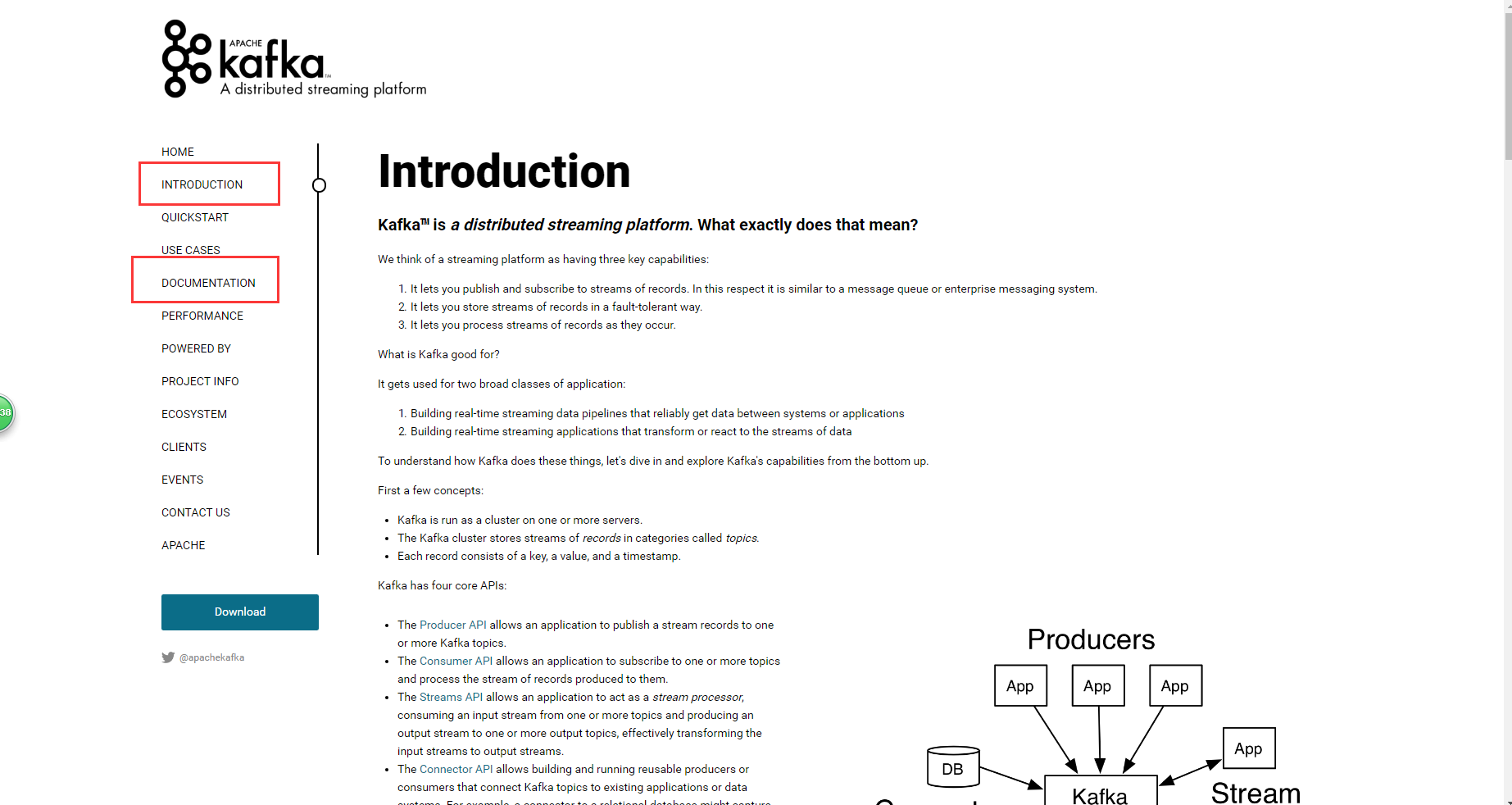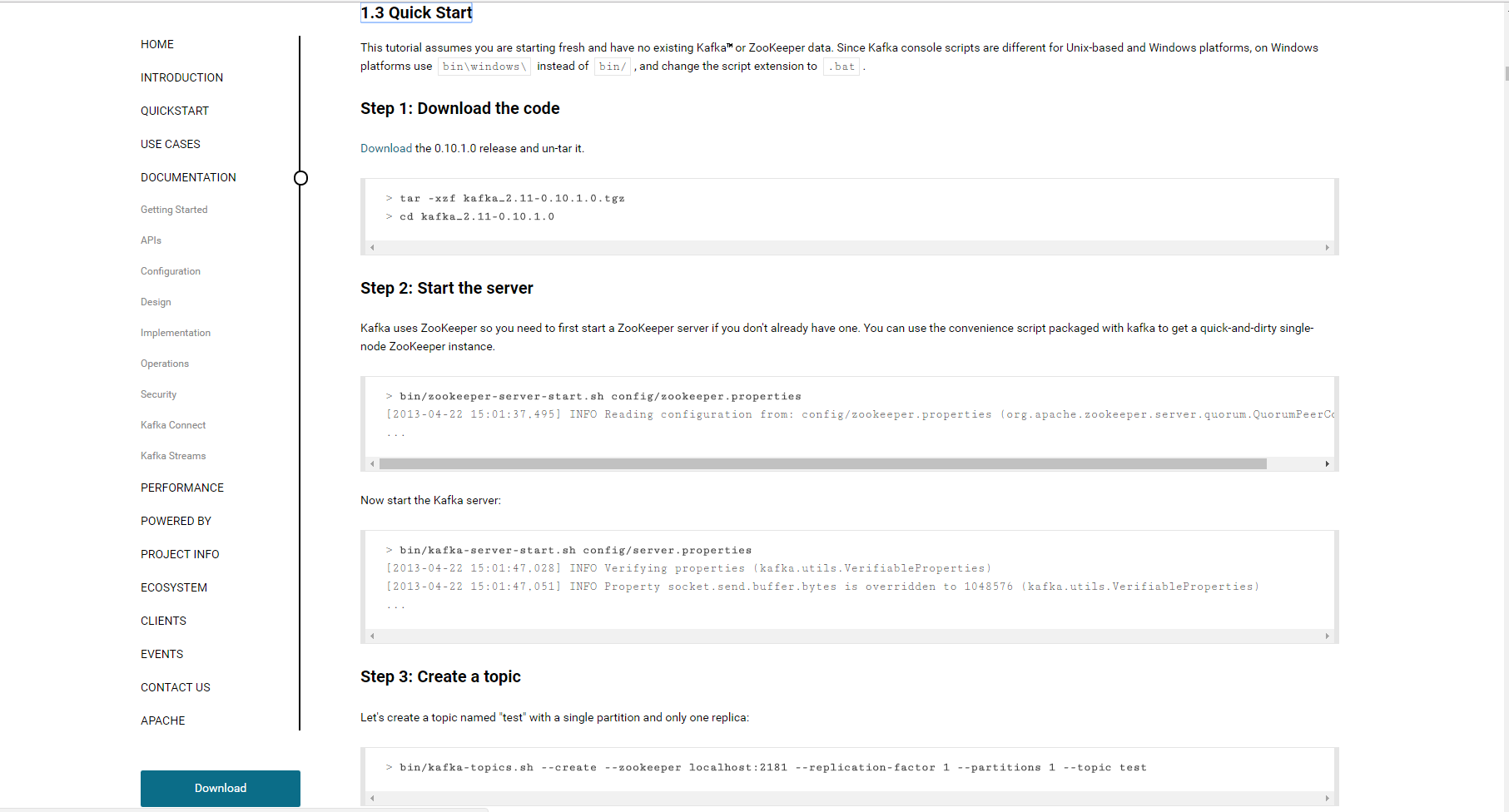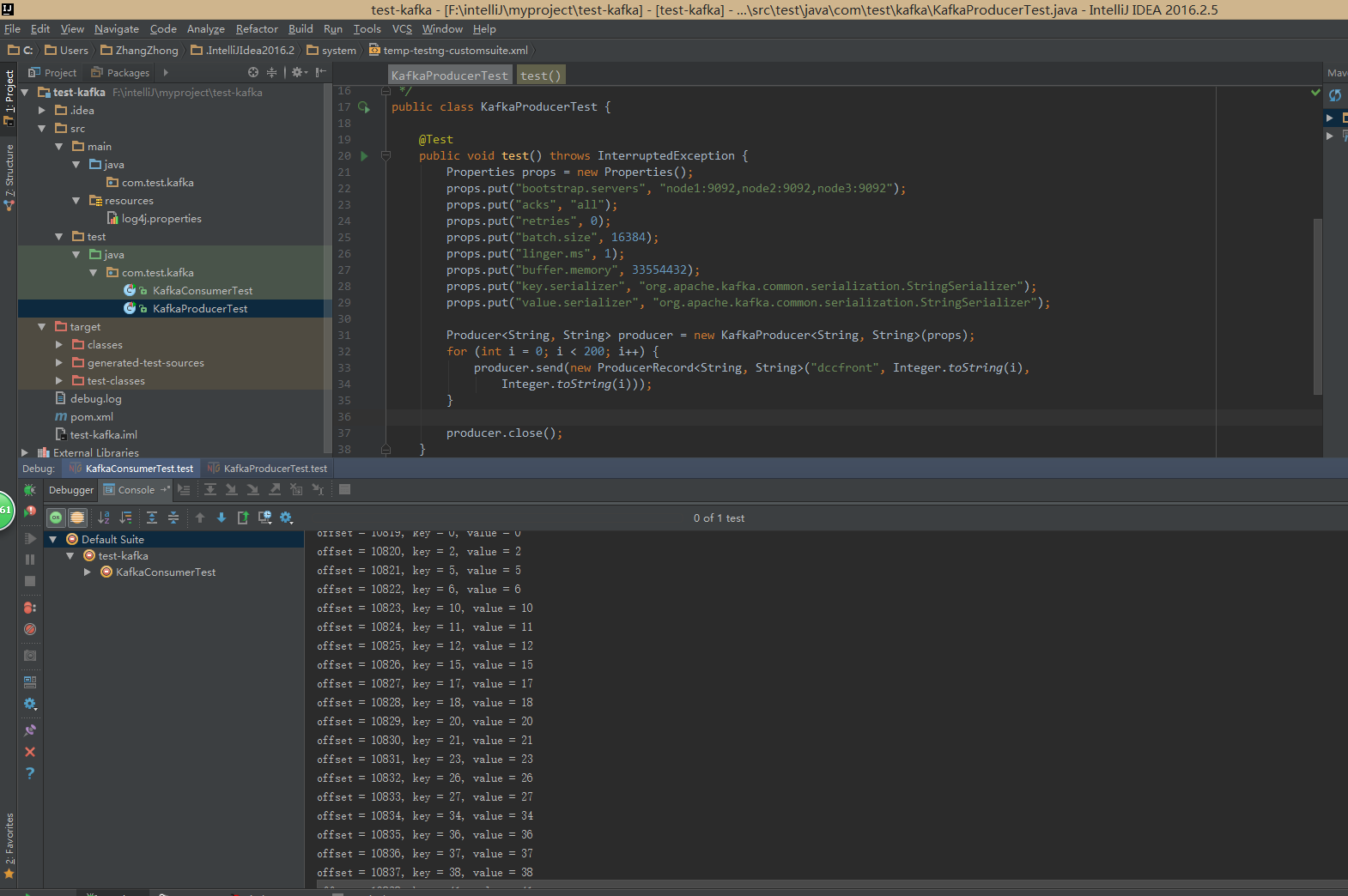storm集群搭建完成之后,自娱自乐的玩了一局dota,JUGG竟然23杀,3死,两度超神,人到高处就只剩孤独寂寞冷啦,喝完一壶花茶,还是决定继续奋战kafka.
同样,小编还是喜欢去官网看看,毕竟好多时间不玩kafka.
 ]
]
建议大家阅读以下Introduction,当然,你也可以直接进入Documentation
看了以下灌完的quick start,描述略简单,只是说要启动Zookeeper,然后再启动kafka

Zookeeper的搭建一如既往的略过,下面直接进入正题,搭建kafka,手头的机器资源如下:
192.168.2.141 node2
192.168.2.142 node3
192.168.2.143 node4
下载kafka,解压等就不做赘述了,直接进入server配置环节:server.prpperties
# Licensed to the Apache Software Foundation (ASF) under one or more
# contributor license agreements. See the NOTICE file distributed with
# this work for additional information regarding copyright ownership.
# The ASF licenses this file to You under the Apache License, Version 2.0
# (the "License"); you may not use this file except in compliance with
# the License. You may obtain a copy of the License at
#
# http://www.apache.org/licenses/LICENSE-2.0
#
# Unless required by applicable law or agreed to in writing, software
# distributed under the License is distributed on an "AS IS" BASIS,
# WITHOUT WARRANTIES OR CONDITIONS OF ANY KIND, either express or implied.
# See the License for the specific language governing permissions and
# limitations under the License.
# see kafka.server.KafkaConfig for additional details and defaults
############################# Server Basics #############################
# The id of the broker. This must be set to a unique integer for each broker.
broker.id=2
# Switch to enable topic deletion or not, default value is false
#delete.topic.enable=true
############################# Socket Server Settings #############################
# The address the socket server listens on. It will get the value returned from
# java.net.InetAddress.getCanonicalHostName() if not configured.
# FORMAT:
# listeners = security_protocol://host_name:port
# EXAMPLE:
# listeners = PLAINTEXT://your.host.name:9092
listeners=PLAINTEXT://:9092
# Hostname and port the broker will advertise to producers and consumers. If not set,
# it uses the value for "listeners" if configured. Otherwise, it will use the value
# returned from java.net.InetAddress.getCanonicalHostName().
advertised.listeners=PLAINTEXT://node2:9092
# The number of threads handling network requests
num.network.threads=3
# The number of threads doing disk I/O
num.io.threads=8
# The send buffer (SO_SNDBUF) used by the socket server
socket.send.buffer.bytes=102400
# The receive buffer (SO_RCVBUF) used by the socket server
socket.receive.buffer.bytes=102400
# The maximum size of a request that the socket server will accept (protection against OOM)
socket.request.max.bytes=104857600
############################# Log Basics #############################
# A comma seperated list of directories under which to store log files
log.dirs=/home/hadoop/app/kafka/kafka-logs
# The default number of log partitions per topic. More partitions allow greater
# parallelism for consumption, but this will also result in more files across
# the brokers.
num.partitions=1
# The number of threads per data directory to be used for log recovery at startup and flushing at shutdown.
# This value is recommended to be increased for installations with data dirs located in RAID array.
num.recovery.threads.per.data.dir=1
############################# Log Flush Policy #############################
# Messages are immediately written to the filesystem but by default we only fsync() to sync
# the OS cache lazily. The following configurations control the flush of data to disk.
# There are a few important trade-offs here:
# 1. Durability: Unflushed data may be lost if you are not using replication.
# 2. Latency: Very large flush intervals may lead to latency spikes when the flush does occur as there will be a lot of data to flush.
# 3. Throughput: The flush is generally the most expensive operation, and a small flush interval may lead to exceessive seeks.
# The settings below allow one to configure the flush policy to flush data after a period of time or
# every N messages (or both). This can be done globally and overridden on a per-topic basis.
# The number of messages to accept before forcing a flush of data to disk
#log.flush.interval.messages=10000
# The maximum amount of time a message can sit in a log before we force a flush
#log.flush.interval.ms=1000
############################# Log Retention Policy #############################
# The following configurations control the disposal of log segments. The policy can
# be set to delete segments after a period of time, or after a given size has accumulated.
# A segment will be deleted whenever *either* of these criteria are met. Deletion always happens
# from the end of the log.
# The minimum age of a log file to be eligible for deletion
log.retention.hours=168
# A size-based retention policy for logs. Segments are pruned from the log as long as the remaining
# segments don't drop below log.retention.bytes.
#log.retention.bytes=1073741824
# The maximum size of a log segment file. When this size is reached a new log segment will be created.
log.segment.bytes=1073741824
# The interval at which log segments are checked to see if they can be deleted according
# to the retention policies
log.retention.check.interval.ms=300000
############################# Zookeeper #############################
# Zookeeper connection string (see zookeeper docs for details).
# This is a comma separated host:port pairs, each corresponding to a zk
# server. e.g. "127.0.0.1:3000,127.0.0.1:3001,127.0.0.1:3002".
# You can also append an optional chroot string to the urls to specify the
# root directory for all kafka znodes.
zookeeper.connect=node1:2181,node2:2181,node3:2181
# Timeout in ms for connecting to zookeeper
zookeeper.connection.timeout.ms=6000
详细参数说明相信大家看一下就懂,望文生义一下...... 唯一要注意的一点是,三个broker的配置可不能一行,各自的host要修改成对应的服务器节点的ip或者机器名称(前提是你配置了hosts)
配置文件完成之后,接下来就是启动集群:
bin/kafka-server-start.sh -daemon config/server.properties 执行这条命令来启动kafka的broker,三台机器都要启动.
-deamon是指以后台进程的形式启动(要不终端关闭或者退出当前的会话都会停止kafka的服务)
接下来测试一下kafka,那就创建一个topic
bin/kafka-topics.sh --create --zookeeper node1:2181,node2:2181,node3:2181 --replication-factor 2 --partitions 2 --topic test
小编默认你会创建成功,就不截图解释了
接下来还是测试一下javaApi,我这里的测试代码需要创建一个叫dccfront的主题:
kafka的生产者
import java.util.Properties;
import org.apache.kafka.clients.producer.KafkaProducer;
import org.apache.kafka.clients.producer.Producer;
import org.apache.kafka.clients.producer.ProducerRecord;
import org.testng.annotations.Test;
/**
* yingyinglicai.com Inc.
* Copyright (c) 2013-2016 All Rights Reserved.
*
* @author ZhangZhong
* @version v 0.1 2016/12/31 11:43 Exp $$
*/
public class KafkaProducerTest {
@Test
public void test() throws InterruptedException {
Properties props = new Properties();
props.put("bootstrap.servers", "node1:9092,node2:9092,node3:9092");
props.put("acks", "all");
props.put("retries", 0);
props.put("batch.size", 16384);
props.put("linger.ms", 1);
props.put("buffer.memory", 33554432);
props.put("key.serializer", "org.apache.kafka.common.serialization.StringSerializer");
props.put("value.serializer", "org.apache.kafka.common.serialization.StringSerializer");
Producer<String, String> producer = new KafkaProducer<String, String>(props);
for (int i = 0; i < 200; i++) {
producer.send(new ProducerRecord<String, String>("dccfront", Integer.toString(i),
Integer.toString(i)));
}
producer.close();
}
}
kafka的消费者
import org.apache.kafka.clients.consumer.ConsumerRecord;
import org.apache.kafka.clients.consumer.ConsumerRecords;
import org.apache.kafka.clients.consumer.KafkaConsumer;
import org.testng.annotations.Test;
import java.util.Arrays;
import java.util.Properties;
/**
* yingyinglicai.com Inc.
* Copyright (c) 2013-2016 All Rights Reserved.
*
* @author ZhangZhong
* @version v 0.1 2016/12/31 17:30 Exp $$
*/
public class KafkaConsumerTest {
@Test
public void test() {
Properties props = new Properties();
props.put("bootstrap.servers", "node1:9092,node2:9092,node3:9092");
props.put("group.id", "test");
props.put("enable.auto.commit", "true");
props.put("auto.commit.interval.ms", "1000");
props.put("key.deserializer", "org.apache.kafka.common.serialization.StringDeserializer");
props.put("value.deserializer", "org.apache.kafka.common.serialization.StringDeserializer");
KafkaConsumer<String, String> consumer = new KafkaConsumer<String, String>(props);
consumer.subscribe(Arrays.asList("dccfront"));
while (true) {
ConsumerRecords<String, String> records = consumer.poll(100);
for (ConsumerRecord<String, String> record : records)
System.out.printf("offset = %d, key = %s, value = %s%n", record.offset(),
record.key(), record.value());
}
}
}
测试的时候,你可先启动consumer,然后再启动producer,再观察consumer的消费情况

/猫小鞭/





















 1335
1335

 被折叠的 条评论
为什么被折叠?
被折叠的 条评论
为什么被折叠?








